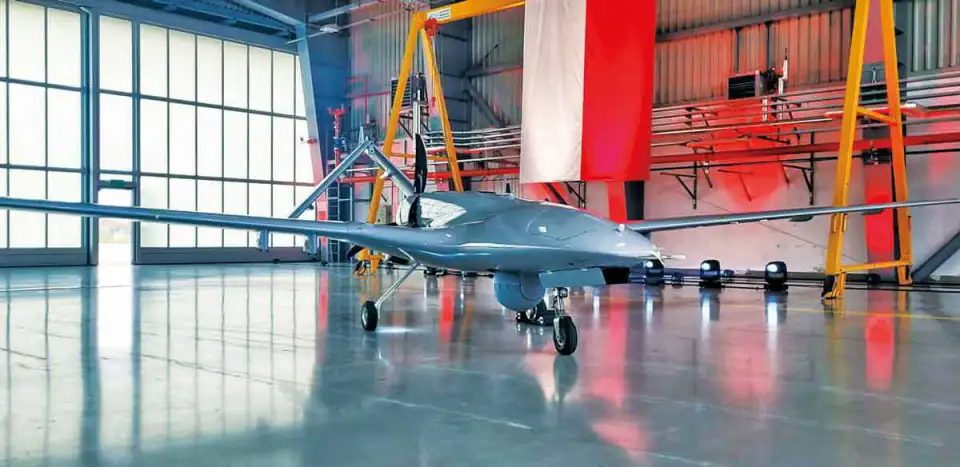
The picture shows a Turkish-made TB2 drone equipped by Poland.
波兰装备的土耳其制TB2无人机。
By Liu Cheng
刘澄
Recently, the interior ministers of six NATO countries, including Estonia, Latvia, Lithuania, Poland, Finland and Norway, jointly decided to build a "drone wall" on their eastern border. Each country will send drones to perform monitoring tasks and share information such as "threat infiltration" in real time to achieve regional integration of intelligence resources.
近日,包括爱沙尼亚、拉脱维亚、立陶宛、波兰、芬兰和挪威在内的北约六国内政部长共同决定,将在其东翼的边境线上建设“无人机防御墙”。各国将派出无人机执行监控任务,实时共享“威胁渗透”等信息,以实现情报资源的区域融合。
Lithuanian Interior Minister Agne Bilotaite said that the "drone wall" starts from Norway in the north and extends along the border between Finland and the three Baltic countries all the way to Poland. It will build an invisible defense wall through a full-coverage and no-dead-angle unmanned surveillance system.
立陶宛内政部长比洛泰特表示,该防御墙北起挪威,沿芬兰和波罗的海三国边境线一直延伸至波兰,将通过“全覆盖、无死角的无人监视系统”构建一道“无形的防卫墙”。
Once the "drone wall" is established, the six NATO countries will form the world's first multinational drone joint force. This force will maintain border security by coordinating troop deployments, likely operating under a shift mechanism. In addition to deploying duty drones, these six countries also plan to deploy various anti-drone systems along their borders to enhance their counter-reconnaissance and counter-infiltration capabilities.
一旦“无人机防御墙”建立,北约六国将组建全球首支多国无人机联合部队,通过统筹调用兵力来维护边境安全,“大轮班”制很可能成为其主要的执勤样式。除派出执勤无人机外,六国还计划在边境线上部署多型反无人机系统,以增强反侦察和反渗透能力。
Analysts pointed out that the six NATO countries are eager to participate in the "drone wall" project because they have their own plans.
分析人士指出,北约六国急于参与“无人机防御墙”项目可谓各有打算。
As the initiator, Poland views the project as part of its plans for "Europe's strongest army," "Europe's defense sentinel," and "war economy mode". Polish Prime Minister Donald Tusk announced a special fund to strengthen border security, and the Polish Ministry of National Defense has openly tendered for the procurement of multiple types of drones. Poland aims to enhance the influence of the so-called new European countries by participating in the "drone wall" project with other nations.
作为倡议发起国,波兰视该项目为其“欧洲最强陆军”“欧洲防务哨兵”和“战争经济模式”计划的组成部分。波兰总理图斯克宣布将投入专项资金加强边境安全,该国国防部也已公开招标采购多型无人机。波兰意图通过参与“无人机防御墙”项目,与其他国家共同提升所谓“新欧洲国家”的话语权。
The three Baltic countries hope to strengthen their military capabilities through this initiative. Lithuania announced the formation of a drone unit within its State Border Guard Service. Estonia said it will advance a combat-reconnaissance integrated drone project and plans to introduce US-made drones. According to reports, due to their unique geographical location, the three Baltic states have always sought collective security within the NATO and EU frameworks, and the "drone wall" project will provide an opportunity for such cooperation.
波罗的海三国希望借此加强军备建设。立陶宛宣布将在边防局内成立无人机部队;爱沙尼亚表示将推进察打一体无人机项目,并计划引进美制无人机。报道称,鉴于地理位置的特殊性,波罗的海三国一直寻求在北约和欧盟框架内的“共同安全”,“无人机防御墙”项目将为其合作提供契机。
As a non-EU member, Norway hopes to leverage this project to intervene in regional affairs and strengthen its presence. Additionally, as the "representative" of the US and other Western countries in Northern Europe, Norway aims to continue playing a significant role in the NATO-established security chain from the Arctic to Eastern Europe.
作为非欧盟成员国,挪威希望借助该项目介入地区事务并加强存在感。同时,作为美国等西方国家在北欧的“代言人”,挪威希望继续在北约设定的极地至东欧安全链中发挥重要作用。
Finland, which joined NATO just over a year ago, hopes to continue expanding its role in European defense through this initiative and gain further support from the US and other countries.
加入北约仅一年多的芬兰,希望借此持续扩大在欧洲防务中的作用,以获得美国等国进一步支持。
The "drone wall" project is a reflection of the "blocization" trend of Europe. NATO's increasing military deployments in Northern and Eastern Europe will lead to a continued escalation of the regional arms race.
“无人机防御墙”项目是欧洲阵营化趋势的一个缩影。北约在北欧和东欧地区不断加码的军事部署,将导致地区军备竞赛持续升级。
Recently, NATO announced the establishment of an additional headquarters for NATO ground forces in the city of Mikkeli in Finland. This command is on "24-hour high alert" and will take over the ground forces of Sweden, Norway, Finland, and other countries during wartime. Shortly thereafter, Finland announced the conversion of three key maritime traffic nodes in the eastern Gulf of Finland into "military border observation points," and it plans to work with Estonia to create an underwater "transportation line" across the Baltic Sea. As the "drone wall" project progresses, NATO's military deployments on its eastern flank will further escalate.
不久前,北约宣布在芬兰的米凯利市设立北欧陆军司令部,该机构处于“24小时高度戒备状态”,战时将接管瑞典、挪威、芬兰等国的地面部队。紧接着,芬兰宣布将芬兰湾东部的3个重要海上交通节点转变为“军事边界观察点”,并与爱沙尼亚联合打造贯通波罗的海的海底“交通线”。随着“无人机防御墙”项目推进,北约在其东翼的军事部署将进一步升级。
Within the EU, compared to traditional "old European countries" like France, Germany, and Italy, the "new European countries" like Poland and Finland tend to enhance their presence in regional affairs through collective efforts. The three Baltic states and several Nordic countries are gradually increasing their defense spending as a percentage of GDP. Following its announcement of a "record-breaking" arms purchase deal, Poland has also bought advanced air-to-ground missiles from the US. Under the influence of the "war economy mode", "new European countries" are expected to be pushed to the forefront of military confrontation.
在欧盟内部,与法国、德国、意大利等传统“老欧洲国家”相比,波兰、芬兰等所谓“新欧洲国家”倾向于通过“抱团”增强在地区事务上的存在感。波罗的海三国和北欧多国正逐步提高其防务开支GDP占比;波兰继公布“创纪录”军购大单后,又从美国购买先进的空对地导弹。预计在“战争经济模式”的作用下,“新欧洲国家”将被推向军事对抗前沿。













